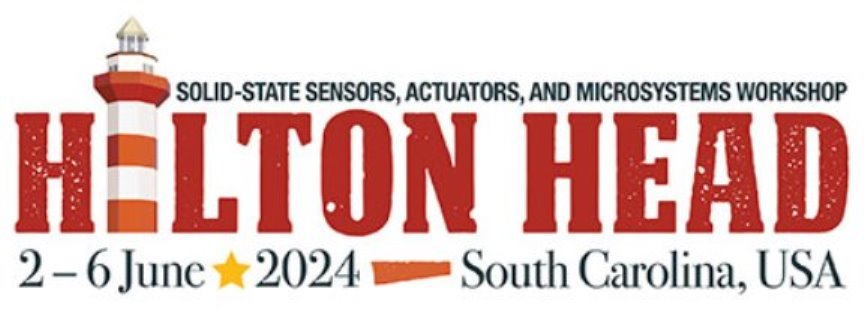-
 Application of Braided Piezoelectric Poly‐l‐Lactic Acid Cord Sensor to Sleep Bruxism Detection System with Less Physical or Mental Stress
Application of Braided Piezoelectric Poly‐l‐Lactic Acid Cord Sensor to Sleep Bruxism Detection System with Less Physical or Mental Stress -
 A Review on Machining SiCp/Al Composite Materials
A Review on Machining SiCp/Al Composite Materials -
 Design of a Micro-Electro Mechanical System Quad Mass Gyroscope with Compliant Mechanical Amplification
Design of a Micro-Electro Mechanical System Quad Mass Gyroscope with Compliant Mechanical Amplification -
 Image-Based Feedback of Multi-Component Microdroplets for Ultra-Monodispersed Library Preparation
Image-Based Feedback of Multi-Component Microdroplets for Ultra-Monodispersed Library Preparation
Journal Description
Micromachines
Micromachines
is a peer-reviewed, open access journal on the science and technology of small structures, devices and systems, published monthly online by MDPI.
- Open Access— free for readers, with article processing charges (APC) paid by authors or their institutions.
- High Visibility: indexed within Scopus, SCIE (Web of Science), PubMed, PMC, Ei Compendex, dblp, and other databases.
- Journal Rank: JCR - Q2 (Chemistry, Analytical) / CiteScore - Q2 (Mechanical Engineering)
- Rapid Publication: manuscripts are peer-reviewed and a first decision is provided to authors approximately 16.1 days after submission; acceptance to publication is undertaken in 1.9 days (median values for papers published in this journal in the second half of 2023).
- Recognition of Reviewers: reviewers who provide timely, thorough peer-review reports receive vouchers entitling them to a discount on the APC of their next publication in any MDPI journal, in appreciation of the work done.
- Testimonials: See what our editors and authors say about Micromachines.
Impact Factor:
3.4 (2022);
5-Year Impact Factor:
3.3 (2022)
Latest Articles
Growing Trend to Adopt Speckle Variance Optical Coherence Tomography for Biological Tissue Assessments in Pre-Clinical Applications
Micromachines 2024, 15(5), 564; https://0-doi-org.brum.beds.ac.uk/10.3390/mi15050564 (registering DOI) - 25 Apr 2024
Abstract
Speckle patterns are a generic feature in coherent imaging techniques like optical coherence tomography (OCT). Although speckles are granular like noise texture, which degrades the image, they carry information that can be benefited by processing and thereby furnishing crucial information of sample structures,
[...] Read more.
Speckle patterns are a generic feature in coherent imaging techniques like optical coherence tomography (OCT). Although speckles are granular like noise texture, which degrades the image, they carry information that can be benefited by processing and thereby furnishing crucial information of sample structures, which can serve to provide significant important structural details of samples in in vivo longitudinal pre-clinical monitoring and assessments. Since the motions of tissue molecules are indicated through speckle patterns, speckle variance OCT (SV-OCT) can be well-utilized for quantitative assessments of speckle variance (SV) in biological tissues. SV-OCT has been acknowledged as a promising method for mapping microvasculature in transverse-directional blood vessels with high resolution in micrometers in both the transverse and depth directions. The fundamental scope of this article reviews the state-of-the-art and clinical benefits of SV-OCT to assess biological tissues for pre-clinical applications. In particular, focus on precise quantifications of in vivo vascular response, therapy assessments, and real-time temporal vascular effects of SV-OCT are primarily emphasized. Finally, SV-OCT-incorporating pre-clinical techniques with high potential are presented for future biomedical applications.
Full article
(This article belongs to the Special Issue Optical Coherence Tomography (OCT) Technique and Its Applications)
Open AccessArticle
Design and Fabrication of 3.5 GHz Band-Pass Film Bulk Acoustic Resonator Filter
by
Yu Zhou, Yupeng Zheng, Qinwen Xu, Yuanhang Qu, Yuqi Ren, Xiaoming Huang, Chao Gao, Yan Liu, Shishang Guo, Yao Cai and Chengliang Sun
Micromachines 2024, 15(5), 563; https://0-doi-org.brum.beds.ac.uk/10.3390/mi15050563 (registering DOI) - 25 Apr 2024
Abstract
With the development of wireless communication, increasing signal processing presents higher requirements for radio frequency (RF) systems. Piezoelectric acoustic filters, as important elements of an RF front-end, have been widely used in 5G-generation systems. In this work, we propose a Sc0.2Al
[...] Read more.
With the development of wireless communication, increasing signal processing presents higher requirements for radio frequency (RF) systems. Piezoelectric acoustic filters, as important elements of an RF front-end, have been widely used in 5G-generation systems. In this work, we propose a Sc0.2Al0.8N-based film bulk acoustic wave resonator (FBAR) for use in the design of radio frequency filters for the 5G mid-band spectrum with a passband from 3.4 to 3.6 GHz. With the excellent piezoelectric properties of Sc0.2Al0.8N, FBAR shows a large
Open AccessCommunication
Wireless Temperature Measurement for Curved Surfaces Based on AlN Surface Acoustic Wave Resonators
by
Huali Liu, Zhixin Zhou and Liang Lou
Micromachines 2024, 15(5), 562; https://0-doi-org.brum.beds.ac.uk/10.3390/mi15050562 (registering DOI) - 25 Apr 2024
Abstract
In this paper, we propose a novel method for temperature measurement using surface acoustic wave (SAW) temperature sensors on curved or irregular surfaces. We integrate SAW resonators onto flexible printed circuit boards (FPCBs) to ensure better conformity of the temperature sensor with the
[...] Read more.
In this paper, we propose a novel method for temperature measurement using surface acoustic wave (SAW) temperature sensors on curved or irregular surfaces. We integrate SAW resonators onto flexible printed circuit boards (FPCBs) to ensure better conformity of the temperature sensor with the surface of the object under test. Compared to traditional rigid PCBs, FPCBs offer greater dynamic flexibility, lighter weight, and thinner thickness, which make them an ideal choice for making SAW devices working for temperature measurements under curved surfaces. We design a temperature sensor array consisting of three devices with different operating frequencies to measure the temperature at multiple points on the surface of the object. To distinguish between different target points in the sensor array, each sensor operates at a different frequency, and the operating frequency bands do not overlap. This differentiation is achieved using Frequency Division Multiple Access (FDMA) technology. Experimental results indicate that the frequency temperature coefficients of these sensors are −30.248 ppm/°C, −30.195 ppm/°C, and −30.115 ppm/°C, respectively. In addition, the sensor array enables wireless communication via antenna and transceiver circuits. This innovation heralds enhanced adaptability and applicability for SAW temperature sensor applications.
Full article
(This article belongs to the Special Issue Micro/Nano Sensors: Fabrication and Applications)
►▼
Show Figures
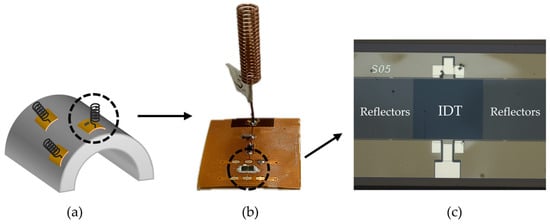
Figure 1
Open AccessArticle
Reliability Study of Metal-Oxide Semiconductors in Integrated Circuits
by
Boris V. Malozyomov, Nikita V. Martyushev, Natalia Nikolaevna Bryukhanova, Viktor V. Kondratiev, Roman V. Kononenko, Pavel P. Pavlov, Victoria V. Romanova and Yuliya I. Karlina
Micromachines 2024, 15(5), 561; https://0-doi-org.brum.beds.ac.uk/10.3390/mi15050561 - 24 Apr 2024
Abstract
This paper is devoted to the study of CMOS IC parameter degradation during reliability testing. The paper presents a review of literature data on the issue of the reliability of semiconductor devices and integrated circuits and the types of failures leading to the
[...] Read more.
This paper is devoted to the study of CMOS IC parameter degradation during reliability testing. The paper presents a review of literature data on the issue of the reliability of semiconductor devices and integrated circuits and the types of failures leading to the degradation of IC parameters. It describes the tests carried out on the reliability of controlled parameters of integrated circuit TPS54332, such as quiescent current, quiescent current in standby mode, resistance of the open key, and instability of the set output voltage in the whole range of input voltages and in the whole range of load currents. The calculated values of activation energies and acceleration coefficients for different test temperature regimes are given. As a result of the work done, sample rejection tests have been carried out on the TPS54332 IC under study. Experimental fail-safe tests were carried out, with subsequent analysis of the chip samples by the controlled parameter quiescent current. On the basis of the obtained experimental values, the values of activation energy and acceleration coefficient at different temperature regimes were calculated. The dependencies of activation energy and acceleration coefficient on temperature were plotted, which show that activation energy linearly increases with increasing temperature, while the acceleration coefficient, on the contrary, decreases. It was also found that the value of the calculated activation energy of the chip is 0.1 eV less than the standard value of the activation energy.
Full article
(This article belongs to the Special Issue High-Reliability Semiconductor Devices and Integrated Circuits, 2nd Edition)
►▼
Show Figures
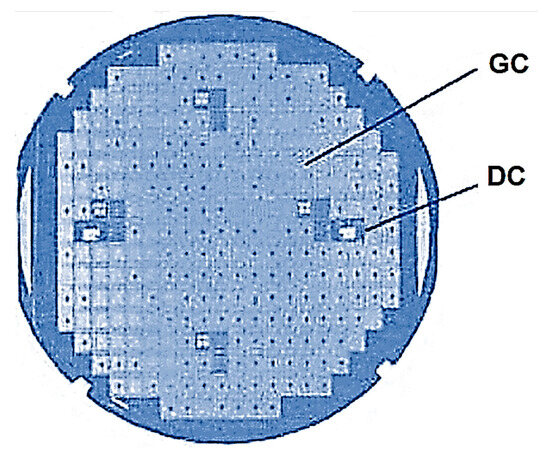
Figure 1
Open AccessArticle
Wafer-Scale Characterization of 1692-Pixel-Per-Inch Blue Micro-LED Arrays with an Optimized ITO Layer
by
Eun-Kyung Chu, Eun Jeong Youn, Hyun Woong Kim, Bum Doo Park, Ho Kun Sung and Hyeong-Ho Park
Micromachines 2024, 15(5), 560; https://0-doi-org.brum.beds.ac.uk/10.3390/mi15050560 - 24 Apr 2024
Abstract
Wafer-scale blue micro-light-emitting diode (micro-LED) arrays were fabricated with a pixel size of 12 μm, a pixel pitch of 15 μm, and a pixel density of 1692 pixels per inch, achieved by optimizing the properties of e-beam-deposited and sputter-deposited indium tin oxide (ITO).
[...] Read more.
Wafer-scale blue micro-light-emitting diode (micro-LED) arrays were fabricated with a pixel size of 12 μm, a pixel pitch of 15 μm, and a pixel density of 1692 pixels per inch, achieved by optimizing the properties of e-beam-deposited and sputter-deposited indium tin oxide (ITO). Although the sputter-deposited ITO (S-ITO) films exhibited a densely packed morphology and lower resistivity compared to the e-beam-deposited ITO (E-ITO) films, the forward voltage (VF) values of a micro-LED with the S-ITO films were higher than those with the E-ITO films. The VF values for a single pixel and for four pixels with E-ITO films were 2.82 V and 2.83 V, respectively, while the corresponding values for S-ITO films were 3.50 V and 3.52 V. This was attributed to ion bombardment damage and nitrogen vacancies in the p-GaN layer. Surprisingly, the VF variations of a single pixel and of four pixels with the optimized E-ITO spreading layer from five different regions were only 0.09 V and 0.10 V, respectively. This extremely uniform VF variation is suitable for creating micro-LED displays to be used in AR and VR applications, circumventing the bottleneck in the development of long-lifespan and high-brightness organic LED devices for industrial mass production.
Full article
(This article belongs to the Special Issue Advanced Thin-Films: Design, Fabrication and Applications, 2nd Edition)
►▼
Show Figures
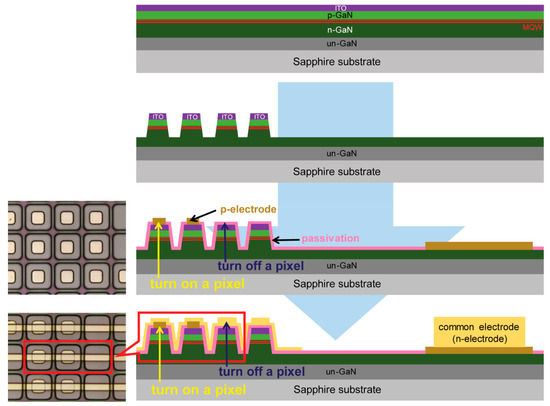
Figure 1
Open AccessReview
Recent Developments in Magnetic Hyperthermia Therapy (MHT) and Magnetic Particle Imaging (MPI) in the Brain Tumor Field: A Scoping Review and Meta-Analysis
by
Frederika Rentzeperis, Daniel Rivera, Jack Y. Zhang, Cole Brown, Tirone Young, Benjamin Rodriguez, Alexander Schupper, Gabrielle Price, Jack Gomberg, Tyree Williams, Alexandros Bouras and Constantinos Hadjipanayis
Micromachines 2024, 15(5), 559; https://0-doi-org.brum.beds.ac.uk/10.3390/mi15050559 - 24 Apr 2024
Abstract
Magnetic hyperthermia therapy (MHT) is a promising treatment modality for brain tumors using magnetic nanoparticles (MNPs) locally delivered to the tumor and activated with an external alternating magnetic field (AMF) to generate antitumor effects through localized heating. Magnetic particle imaging (MPI) is an
[...] Read more.
Magnetic hyperthermia therapy (MHT) is a promising treatment modality for brain tumors using magnetic nanoparticles (MNPs) locally delivered to the tumor and activated with an external alternating magnetic field (AMF) to generate antitumor effects through localized heating. Magnetic particle imaging (MPI) is an emerging technology offering strong signal-to-noise for nanoparticle localization. A scoping review was performed by systematically querying Pubmed, Scopus, and Embase. In total, 251 articles were returned, 12 included. Articles were analyzed for nanoparticle type used, MHT parameters, and MPI applications. Preliminary results show that MHT is an exciting treatment modality with unique advantages over current heat-based therapies for brain cancer. Effective application relies on the further development of unique magnetic nanoparticle constructs and imaging modalities, such as MPI, that can enable real-time MNP imaging for improved therapeutic outcomes.
Full article
(This article belongs to the Special Issue Magnetic Materials and Devices)
►▼
Show Figures
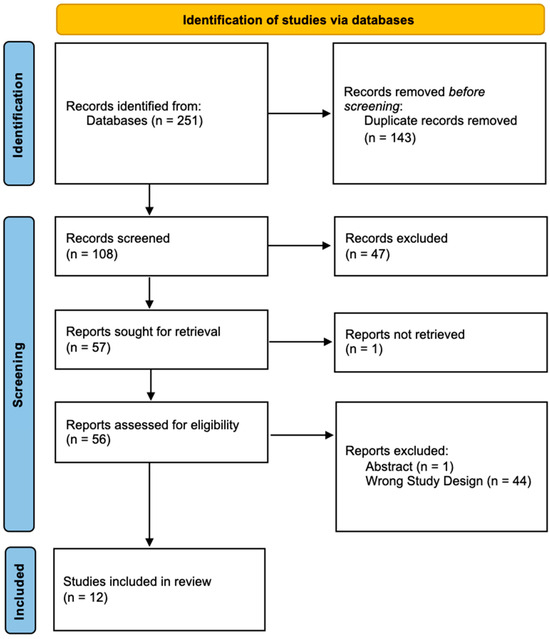
Figure 1
Open AccessArticle
Hybrid Filtering Compensation Algorithm for Suppressing Random Errors in MEMS Arrays
by
Siyuan Liang, Tianyu Guo, Rongrong Chen and Xuguang Li
Micromachines 2024, 15(5), 558; https://0-doi-org.brum.beds.ac.uk/10.3390/mi15050558 - 24 Apr 2024
Abstract
►▼
Show Figures
To solve the high error phenomenon of microelectromechanical systems (MEMS) due to their poor signal-to-noise ratio, this paper proposes an online compensation algorithm wavelet threshold back-propagation neural network (WT-BPNN), based on a neural network and designed to effectively suppress the random error of
[...] Read more.
To solve the high error phenomenon of microelectromechanical systems (MEMS) due to their poor signal-to-noise ratio, this paper proposes an online compensation algorithm wavelet threshold back-propagation neural network (WT-BPNN), based on a neural network and designed to effectively suppress the random error of MEMS arrays. The algorithm denoises MEMS and compensates for the error using a back propagation neural network (BPNN). To verify the feasibility of the proposed algorithm, we deployed it in a ZYNQ-based MEMS array hardware. The experimental results showed that the zero-bias instability, angular random wander, and angular velocity random wander of the gyroscope were improved by about 12 dB, 10 dB, and 7 dB, respectively, compared with the original device in static scenarios, and the dispersion of the output data was reduced by about 8 dB in various dynamic environments, which effectively verified the robustness and feasibility of the algorithm.
Full article
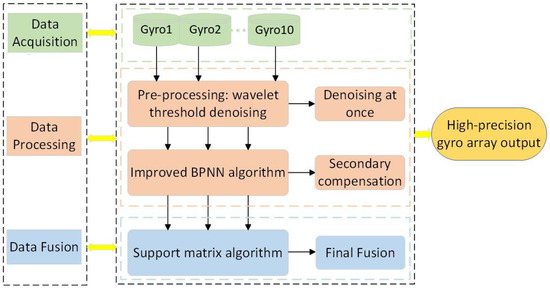
Figure 1
Open AccessArticle
A Cross-Process Signal Integrity Analysis (CPSIA) Method and Design Optimization for Wafer-on-Wafer Stacked DRAM
by
Xiping Jiang, Xuerong Jia, Song Wang, Yixin Guo, Fuzhi Guo, Xiaodong Long, Li Geng, Jianguo Yang and Ming Liu
Micromachines 2024, 15(5), 557; https://0-doi-org.brum.beds.ac.uk/10.3390/mi15050557 - 23 Apr 2024
Abstract
A multi-layer stacked Dynamic Random Access Memory (DRAM) platform is introduced to address the memory wall issue. This platform features high-density vertical interconnects established between DRAM units for high-capacity memory and logic units for computation, utilizing Wafer-on-Wafer (WoW) hybrid bonding and mini Through-Silicon
[...] Read more.
A multi-layer stacked Dynamic Random Access Memory (DRAM) platform is introduced to address the memory wall issue. This platform features high-density vertical interconnects established between DRAM units for high-capacity memory and logic units for computation, utilizing Wafer-on-Wafer (WoW) hybrid bonding and mini Through-Silicon Via (TSV) technologies. This 3DIC architecture includes commercial DRAM, logic, and 3DIC manufacturing processes. Their design documents typically come from different foundries, presenting challenges for signal integrity design and analysis. This paper establishes a lumped circuit based on 3DIC physical structure and calculates all values of the lumped elements in the circuit model with the transmission line model. A Cross-Process Signal Integrity Analysis (CPSIA) method is introduced, which integrates three different manufacturing processes by modeling vertical stacking cells and connecting DRAM and logic netlists in one simulation environment. In combination with the dedicated buffer driving method, the CPSIA method is used to analyze 3DIC impacts. Simulation results show that the timing uncertainty introduced by 3DIC crosstalk ranges from 31 ps to 62 ps. This analysis result explains the stable slight variation in the maximum frequency observed in vertically stacked memory arrays from different DRAM layers in the physical testing results, demonstrating the effectiveness of this CPSIA method.
Full article
(This article belongs to the Special Issue Latest Advancements in Semiconductor Materials, Devices, and Systems)
►▼
Show Figures

Figure 1
Open AccessReview
MEMS Switch Realities: Addressing Challenges and Pioneering Solutions
by
Kurmendra and Saurabh Agarwal
Micromachines 2024, 15(5), 556; https://0-doi-org.brum.beds.ac.uk/10.3390/mi15050556 (registering DOI) - 23 Apr 2024
Abstract
Micro-Electro-Mechanical System (MEMS) switches have emerged as pivotal components in the realm of miniature electronic devices, promising unprecedented advancements in size, power consumption, and versatility. This literature review paper meticulously examines the key issues and challenges encountered in the development and application of
[...] Read more.
Micro-Electro-Mechanical System (MEMS) switches have emerged as pivotal components in the realm of miniature electronic devices, promising unprecedented advancements in size, power consumption, and versatility. This literature review paper meticulously examines the key issues and challenges encountered in the development and application of MEMS switches. The comprehensive survey encompasses critical aspects such as material selection, fabrication intricacies, performance metrics including switching time and reliability, and the impact of these switches on diverse technological domains. The review critically analyzes the influence of design parameters, actuation mechanisms, and material properties on the performance of MEMS switches. Additionally, it explores recent advancements, breakthroughs, and innovative solutions proposed by researchers to address these challenges. The synthesis of the existing literature not only elucidates the current state of MEMS switch technology but also paves the way for future research avenues. The findings presented herein serve as a valuable resource for researchers, engineers, and technologists engaged in advancing MEMS switch technology, offering insights into the current landscape and guiding future endeavors in this rapidly evolving field.
Full article
(This article belongs to the Special Issue MEMS/NEMS for Sensing: Array, Integration, Intelligence and Application)
►▼
Show Figures
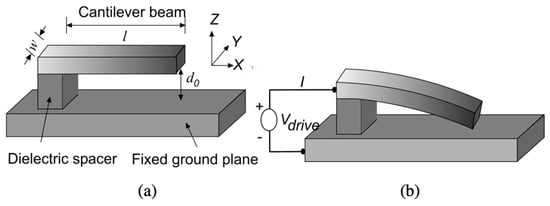
Figure 1
Open AccessArticle
Rational Design of a Surface Acoustic Wave Device for Wearable Body Temperature Monitoring
by
Yudi Xie, Minglong Deng, Jinkai Chen, Yue Duan, Jikai Zhang, Danyu Mu, Shurong Dong, Jikui Luo, Hao Jin and Shoji Kakio
Micromachines 2024, 15(5), 555; https://0-doi-org.brum.beds.ac.uk/10.3390/mi15050555 - 23 Apr 2024
Abstract
Continuous monitoring of vital signs based on advanced sensing technologies has attracted extensive attention due to the ravages of COVID-19. A maintenance-free and low-cost passive wireless sensing system based on surface acoustic wave (SAW) device can be used to continuously monitor temperature. However,
[...] Read more.
Continuous monitoring of vital signs based on advanced sensing technologies has attracted extensive attention due to the ravages of COVID-19. A maintenance-free and low-cost passive wireless sensing system based on surface acoustic wave (SAW) device can be used to continuously monitor temperature. However, the current SAW-based passive sensing system is mostly designed at a low frequency around 433 MHz, which leads to the relatively large size of SAW devices and antenna, hindering their application in wearable devices. In this paper, SAW devices with a resonant frequency distributed in the 870 MHz to 960 MHz range are rationally designed and fabricated. Based on the finite-element method (FEM) and coupling-of-modes (COM) model, the device parameters, including interdigital transducer (IDT) pairs, aperture size, and reflector pairs, are systematically optimized, and the theoretical and experimental results show high consistency. Finally, SAW temperature sensors with a quality factor greater than 2200 are obtained for real-time temperature monitoring ranging from 20 to 50 °C. Benefitting from the higher operating frequency, the size of the sensing system can be reduced for human body temperature monitoring, showing its potential to be used as a wearable monitoring device in the future.
Full article
(This article belongs to the Special Issue Novel Surface and Bulk Acoustic Wave Devices)
►▼
Show Figures

Figure 1
Open AccessArticle
A Five-Hole Pressure Probe Based on Integrated MEMS Fiber-Optic Fabry-Perot Sensors
by
Yumiao Song, Shuanghui Ma, Jichun Zhao, Jia Liu, Jingyi Wang and Yongjun Cui
Micromachines 2024, 15(4), 554; https://0-doi-org.brum.beds.ac.uk/10.3390/mi15040554 - 22 Apr 2024
Abstract
The five-hole pressure probe based on Micro-Electro-Mechanical Systems (MEMS) technology is designed to meet the needs of engine inlet pressure measurement. The probe, including a pressure-sensitive detection unit and a five-hole probe encapsulation structure, combines the advantages of a five-hole probe with fiber
[...] Read more.
The five-hole pressure probe based on Micro-Electro-Mechanical Systems (MEMS) technology is designed to meet the needs of engine inlet pressure measurement. The probe, including a pressure-sensitive detection unit and a five-hole probe encapsulation structure, combines the advantages of a five-hole probe with fiber optic sensing. The pressure-sensitive detection unit utilizes silicon-glass anodic bonding to achieve the integrated and batch-producible manufacturing of five pressure-sensitive Fabry–Perot (FP) cavities. The probe structure and parameters of the sensitive unit were optimized based on fluid and mechanical simulations. The non-scanning correlation demodulation technology was applied to extract specific cavity lengths from multiple interference surfaces. The sealing platform was established to analyze the sealing performance of the five-hole probe and the pressure-sensitive detection unit. The testing platform was established to test the pressure response characteristics of the probe. Experimental results indicate that the probe has good sealing performance between different air passages, making it suitable for detecting pressure from multiple directions. The pressure responses are linear within the range of 0–250 kPa, with the average pressure sensitivity of the five sensors ranging from 11.061 to 11.546 nm/kPa. The maximum non-linear error is ≤1.083%.
Full article
(This article belongs to the Special Issue Micro/Nano Sensors: Fabrication and Applications)
►▼
Show Figures
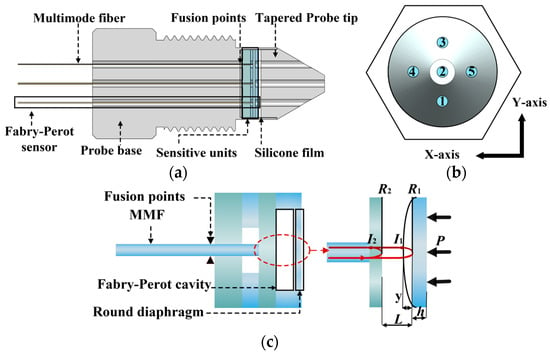
Figure 1
Open AccessArticle
Robust Orientation Estimation from MEMS Magnetic, Angular Rate, and Gravity (MARG) Modules for Human–Computer Interaction
by
Pontakorn Sonchan, Neeranut Ratchatanantakit, Nonnarit O-Larnnithipong, Malek Adjouadi and Armando Barreto
Micromachines 2024, 15(4), 553; https://0-doi-org.brum.beds.ac.uk/10.3390/mi15040553 - 21 Apr 2024
Abstract
While the availability of low-cost micro electro-mechanical systems (MEMS) accelerometers, gyroscopes, and magnetometers initially seemed to promise the possibility of using them to easily track the position and orientation of virtually any object that they could be attached to, this promise has not
[...] Read more.
While the availability of low-cost micro electro-mechanical systems (MEMS) accelerometers, gyroscopes, and magnetometers initially seemed to promise the possibility of using them to easily track the position and orientation of virtually any object that they could be attached to, this promise has not yet been fulfilled. Navigation-grade accelerometers and gyroscopes have long been the basis for tracking ships and aircraft, but the signals from low-cost MEMS accelerometers and gyroscopes are still orders of magnitude poorer in quality (e.g., bias stability). Therefore, the applications of MEMS inertial measurement units (IMUs), containing tri-axial accelerometers and gyroscopes, are currently not as extensive as they were expected to be. Even the addition of MEMS tri-axial magnetometers, to conform magnetic, angular rate, and gravity (MARG) sensor modules, has not fully overcome the challenges involved in using these modules for long-term orientation estimation, which would be of great benefit for the tracking of human–computer hand-held controllers or tracking of Internet-Of-Things (IoT) devices. Here, we present an algorithm, GMVDμK (or simply GMVDK), that aims at taking full advantage of all the signals available from a MARG module to robustly estimate its orientation, while preventing damaging overcorrections, within the context of a human–computer interaction application. Through experimental comparison, we show that GMVDK is more robust to magnetic disturbances than three other MARG orientation estimation algorithms in representative trials.
Full article
(This article belongs to the Special Issue Exploring IoT Sensors and Their Applications: Advancements, Challenges, and Opportunities in Smart Environments)
►▼
Show Figures
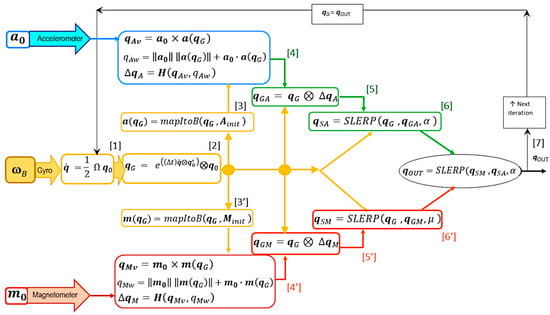
Figure 1
Open AccessArticle
Secure ECDSA SRAM-PUF Based on Universal Single/Double Scalar Multiplication Architecture
by
Jingqi Zhang, Zhiming Chen, Xiang He, Kuanhao Liu, Yue Hao, Mingzhi Ma, Weijiang Wang, Hua Dang and Xiangnan Li
Micromachines 2024, 15(4), 552; https://0-doi-org.brum.beds.ac.uk/10.3390/mi15040552 - 21 Apr 2024
Abstract
►▼
Show Figures
Physically unclonable functions (PUFs) are crucial for enhancing cybersecurity by providing unique, intrinsic identifiers for electronic devices, thus ensuring their authenticity and preventing unauthorized cloning. The SRAM-PUF, characterized by its simple structure and ease of implementation in various scenarios, has gained widespread usage.
[...] Read more.
Physically unclonable functions (PUFs) are crucial for enhancing cybersecurity by providing unique, intrinsic identifiers for electronic devices, thus ensuring their authenticity and preventing unauthorized cloning. The SRAM-PUF, characterized by its simple structure and ease of implementation in various scenarios, has gained widespread usage. The soft-decision Reed–Muller (RM) code, an error correction code, is commonly employed in these designs. This paper introduces the design of an RM code soft-decision attack algorithm to reveal its potential security risks. To address this problem, we propose a soft-decision SRAM-PUF structure based on the elliptic curve digital signature algorithm (ECDSA). To improve the processing speed of the proposed secure SRAM-PUF, we propose a custom ECDSA scheme. Further, we also propose a universal architecture for the critical operations in ECDSA, elliptic curve scalar multiplication (ECSM), and elliptic curve double scalar multiplication (ECDSM) based on the differential addition chain (DAC). For ECSMs, iterations can be performed directly; for ECDSMs, a two-dimensional DAC is constructed through precomputation, followed by iterations. Moreover, due to the high similarity of ECSM and ECDSM data paths, this universal architecture saves hardware resources. Our design is implemented on a field-programmable gate array (FPGA) and an application-specific integrated circuit (ASIC) using a Xilinx Virtex-7 and an TSMC 40 nm process. Compared to existing research, our design exhibits a lower bit error rate (
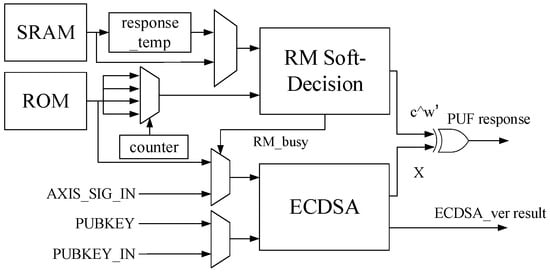
Figure 1
Open AccessArticle
Enhancing Thickness Uniformity of Nb2O5/SiO2 Multilayers Using Shadow Masks for Flexible Color-Filtering Applications
by
Tzu-Chien Li, Dong-Lin Li, Jiashow Ho, Chih-Chiang Yu, Sheng-Shih Wang and Jyh-Jier Ho
Micromachines 2024, 15(4), 551; https://0-doi-org.brum.beds.ac.uk/10.3390/mi15040551 - 21 Apr 2024
Abstract
Using a stainless shadow mask combined with a magnetron-ion-assisted deposition (IAD) sputtering system, we investigate the surface morphologies and optical properties of microfilms. Optimal color-filter (CF) coating microfilms with niobium pent-oxide (Nb2O5)/silicon dioxide (SiO2) multilayers on a
[...] Read more.
Using a stainless shadow mask combined with a magnetron-ion-assisted deposition (IAD) sputtering system, we investigate the surface morphologies and optical properties of microfilms. Optimal color-filter (CF) coating microfilms with niobium pent-oxide (Nb2O5)/silicon dioxide (SiO2) multilayers on a hard polycarbonate (HPC) substrate, grown at 85 °C and 50 SCCM oxygen flow, can obtain a fairly uniform thickness (with an average roughness of 0.083 and 0.106 nm respectively for Nb2O5 and SiO2 films) through all positions. On a flexible HPC substrate with the Nb2O5/SiO2 microfilms, meanwhile, the peak transmittances measured in the visible range are 95.70% and 91.47%, respectively, for coatings with and without a shadow mask for this new-tech system. For the optimal CF application with a shadow mask, transmittance on each 100 nm band-pass wavelength is enhanced by 4.04% absolute (blue), 2.96% absolute (green), and 2.12% absolute (red). Moreover, the developed new-tech system not only enhances the quality of the films by achieving smoother and uniform surfaces but also reduces deposition time, thereby improving overall process efficiency. For the with-shadow-mask condition, there is little shift at 50% transmittance (T50%), and high transmittance (~97%) is maintained after high-temperature (200 °C) baking for 12 h. These results are well above the commercial CF standard (larger than 90%) and demonstrate reliability and good durability for flexible optical applications.
Full article
(This article belongs to the Special Issue Multi-Dimensional (1D, 2D, 3D) Micro/Nanocomposite Thin Films and Crystals)
►▼
Show Figures
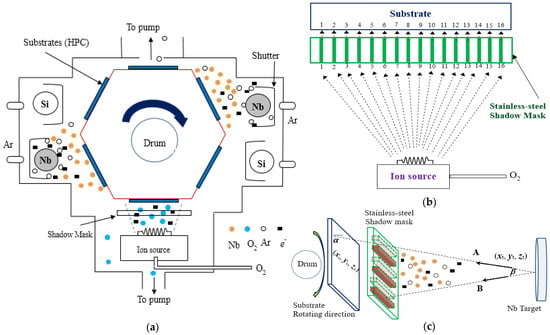
Figure 1
Open AccessArticle
Electromagnetic Acoustic Detection of Pipe Defects Hidden above T-Type Support Structures with Circumferential Shear Horizontal Guided Wave
by
Xingjun Zhang, Jinjie Zhou, Yang Hu, Yao Liu and Xingquan Shen
Micromachines 2024, 15(4), 550; https://0-doi-org.brum.beds.ac.uk/10.3390/mi15040550 - 20 Apr 2024
Abstract
When pipe defects are generated above the T-type support structure location, it is difficult to distinguish the reflection signals caused by the weld bead at the support structure from the reflection echoes of pipe defects. Therefore, in order to effectively detect pipe defects,
[...] Read more.
When pipe defects are generated above the T-type support structure location, it is difficult to distinguish the reflection signals caused by the weld bead at the support structure from the reflection echoes of pipe defects. Therefore, in order to effectively detect pipe defects, a waveform subtraction method with a circumferential shear horizontal (CSH) guided wave is proposed, which is generated by an electromagnetic acoustic transducer (EMAT). First, a CSH0 guided wave mode with a center frequency of 500 kHz is selected to establish a three-dimensional model with and without pipe defects above the support structure. Following this, the influence of different widths of support structures on the echo signal is compared. Moreover, simulation and experimental results are used to compare the influence of different welding qualities on the detection results. Finally, the waveform subtraction method is used to process the simulation and experimental signals, and the influence of pipe defects with different lengths and depths is discussed. The results show that the non-through crack defect of 5 mm × 1 mm (length × depth) can be detected. The results show that this method can effectively detect the cracks by eliminating the influence of the weld echo, which provides a new concept for the detection of the defect above the support structure.
Full article
(This article belongs to the Special Issue Acoustic Transducers and Their Applications)
►▼
Show Figures
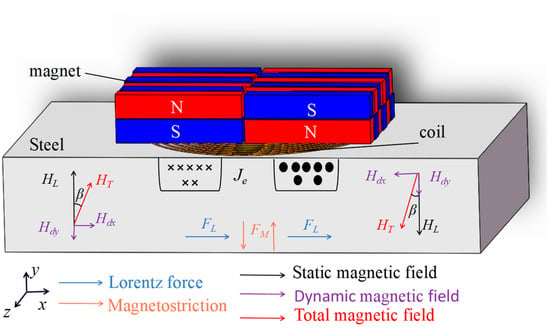
Figure 1
Open AccessArticle
Optimization of Graphical Parameter Extraction Algorithm for Chip-Level CMP Prediction Model Based on Effective Planarization Length
by
Bowen Ren, Lan Chen, Rong Chen, Yan Sun and Yali Wang
Micromachines 2024, 15(4), 549; https://0-doi-org.brum.beds.ac.uk/10.3390/mi15040549 - 19 Apr 2024
Abstract
As a planarization technique, chemical mechanical polishing (CMP) continues to suffer from pattern effects that result in large variations in material thickness, which can influence circuit performance and yield. Therefore, tools for predicting post-CMP chip morphology based on the layout-dependent effect (LDE) have
[...] Read more.
As a planarization technique, chemical mechanical polishing (CMP) continues to suffer from pattern effects that result in large variations in material thickness, which can influence circuit performance and yield. Therefore, tools for predicting post-CMP chip morphology based on the layout-dependent effect (LDE) have become increasingly critical and widely utilized for design verification and manufacturing development. In order to characterize the impact of patterns on polishing, such models often require the extraction of graphic parameters. However, existing extraction algorithms provide a limited description of the interaction effect between layout patterns. To address this problem, we calculate the average density as a density correction and innovatively use a one-dimensional line contact deformation profile as a weighting function. To verify our hypothesis, the density correction method is applied to a density step-height-based high-K metal gate-CMP prediction model. The surface prediction results before and after optimization are compared with the silicon data. The results show a reduction in mean squared error (MSE) of 40.1% and 35.2% in oxide and Al height predictions, respectively, compared with the preoptimization results, confirming that the optimization method can improve the prediction accuracy of the model.
Full article
(This article belongs to the Special Issue Advances in Micro and Nano Manufacturing: Process Modeling and Applications, 3rd Edition)
►▼
Show Figures
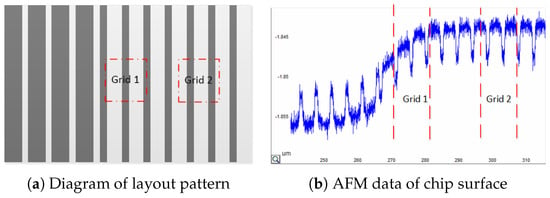
Figure 1
Open AccessArticle
Research on Vibration Accumulation Self-Powered Downhole Sensor Based on Triboelectric Nanogenerators
by
Rui Wang, Jianchao Ren, Weibo Ding, Maofu Liu, Guangzhi Pan and Chuan Wu
Micromachines 2024, 15(4), 548; https://0-doi-org.brum.beds.ac.uk/10.3390/mi15040548 - 19 Apr 2024
Abstract
►▼
Show Figures
In drilling operations, measuring vibration parameters is crucial for enhancing drilling efficiency and ensuring safety. Nevertheless, the conventional vibration measurement sensor significantly extends the drilling cycle due to its dependence on an external power source. Therefore, we propose a vibration-accumulation-type self-powered sensor in
[...] Read more.
In drilling operations, measuring vibration parameters is crucial for enhancing drilling efficiency and ensuring safety. Nevertheless, the conventional vibration measurement sensor significantly extends the drilling cycle due to its dependence on an external power source. Therefore, we propose a vibration-accumulation-type self-powered sensor in this research, aiming to address these needs. By leveraging vibration accumulation and electromagnetic power generation to accelerate charging, the sensor’s output performance is enhanced through a complementary charging mode. The experimental results regarding sensing performance demonstrate that the sensor possesses a measurement range spanning from 0 to 11 Hz, with a linearity of 3.2% and a sensitivity of 1.032. Additionally, it exhibits a maximum average measurement error of less than 4%. The experimental results of output performance measurement indicate that the sensor unit and generator set exhibit a maximum output power of 0.258 μW and 25.5 mW, respectively, and eight LED lights can be lit at the same time. When the sensor unit and power generation unit output together, the maximum output power of the sensor is also 25.5 mW. Furthermore, we conducted tests on the sensor’s output signal in conditions of high temperature and humidity, confirming its continued functionality in such environments. This sensor not only achieves self-powered sensing capabilities, addressing the power supply challenges faced by traditional downhole sensors, but also integrates energy accumulation with electromagnetic power generation to enhance its output performance. This innovation enables the sensor to harness downhole vibration energy for powering other micro-power devices, showcasing promising application prospects.
Full article
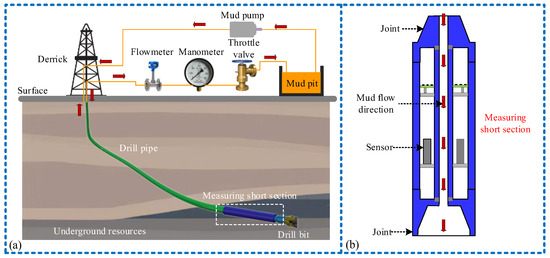
Figure 1
Open AccessReview
Research and Application Progress of Laser-Processing Technology in Diamond Micro-Fabrication
by
Yangfan Zhang, Shuai Xu, E-Nuo Cui, Ling Yu and Zhan Wang
Micromachines 2024, 15(4), 547; https://0-doi-org.brum.beds.ac.uk/10.3390/mi15040547 - 18 Apr 2024
Abstract
Laser-processing technology has been widely used in the ultra-precision machining of diamond materials. It has the advantages of high precision and high efficiency, especially in the field of super-hard materials and high-precision parts manufacturing. This paper explains the fundamental principles of diamond laser
[...] Read more.
Laser-processing technology has been widely used in the ultra-precision machining of diamond materials. It has the advantages of high precision and high efficiency, especially in the field of super-hard materials and high-precision parts manufacturing. This paper explains the fundamental principles of diamond laser processing, introduces the interaction mechanisms between various types of lasers and diamond materials, focuses on analyzing the current development status of various modes of laser processing of diamond, briefly discusses the relevant applications in diamond cutting, micro-hole forming, and micro-groove machining, etc., and finally discusses the issues, challenges, and potential future advancements of laser technology in the field of diamond processing at this point.
Full article
(This article belongs to the Special Issue Advanced Manufacturing Technology and Systems, 3rd Edition)
►▼
Show Figures
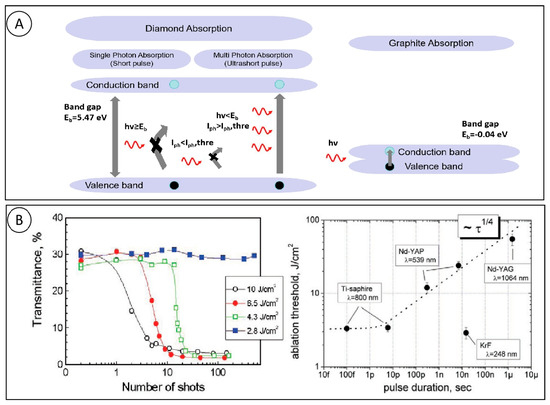
Figure 1
Open AccessArticle
Ultra-Wideband Transformer Feedback Monolithic Microwave Integrated Circuit Power Amplifier Design on 0.25 μm GaN Process
by
Jialin Luo, Yihui Fan, Jing Wan, Xuming Sun and Xiaoxin Liang
Micromachines 2024, 15(4), 546; https://0-doi-org.brum.beds.ac.uk/10.3390/mi15040546 - 18 Apr 2024
Abstract
This paper presents an ultra-wideband transformer feedback (TFB) monolithic microwave integrated circuit (MMIC) power amplifier (PA) developed using a 0.25 μm gallium nitride (GaN) process. To broaden the bandwidth, a drain-to-gate TFB technique is employed in this PA design, achieving a 117% relative
[...] Read more.
This paper presents an ultra-wideband transformer feedback (TFB) monolithic microwave integrated circuit (MMIC) power amplifier (PA) developed using a 0.25 μm gallium nitride (GaN) process. To broaden the bandwidth, a drain-to-gate TFB technique is employed in this PA design, achieving a 117% relative −3 dB bandwidth, extending from 5.4 GHz to 20.3 GHz. At a 28 V supply, the designed PA circuit achieves an output power of 25.5 dBm and a 14 dB small-signal gain in the frequency range of 6 to 19 GHz. Within the 6 to 19 GHz frequency range, the small-signal gain exhibits a flatness of less than 0.78 dB. The PA chip occupies an area of 1.571 mm2. This work is the first to design a power amplifier with on-chip transformer feedback in a compound semiconductor MMIC process, and it enables the use of the widest bandwidth power amplifier on-chip transformer matching network.
Full article
(This article belongs to the Special Issue Advances in GaN- and SiC-Based Electronics: Design and Applications)
►▼
Show Figures
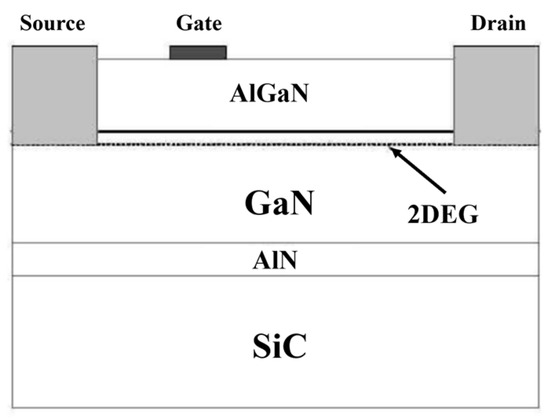
Figure 1
Open AccessArticle
Resistance Feedback of a Ni-Ti Alloy Actuator at Room Temperature in Still Air
by
Francesco Durante, Terenziano Raparelli and Pierluigi Beomonte Zobel
Micromachines 2024, 15(4), 545; https://0-doi-org.brum.beds.ac.uk/10.3390/mi15040545 - 18 Apr 2024
Abstract
This paper illustrates an experimental activity for the closed-loop position control of an actuator made using shape memory alloy (SMA) wire. A solution with the self-sensing effect was implemented to miniaturize the systems, i.e., without external sensors. A proportional control algorithm was initially
[...] Read more.
This paper illustrates an experimental activity for the closed-loop position control of an actuator made using shape memory alloy (SMA) wire. A solution with the self-sensing effect was implemented to miniaturize the systems, i.e., without external sensors. A proportional control algorithm was initially used, demonstrating the idea’s feasibility; the wire can behave simultaneously as an actuator and sensor. An experimental investigation was subsequently conducted for the optimization of the developed actuator. As for the material, a Flexinol wire, Ni-Ti alloy, with a diameter of 0.150 mm and a length of 200 mm, was used. Preliminarily, characterization of the SMA wire at constant and variable loads was carried out; the characteristics detected were elongation vs. electric current and elongation vs. electrical resistance. The control system is PC based with a data acquisition card (DAQ). A drive board was designed and built to read the wire’s electrical resistance and power it by pulse width modulation (PWM). A notable result is that the actuator works with good precision and in dynamic conditions, even when it is called to support a load up to 65% different from that for which the electrical resistance–length correlation has previously been experimentally obtained, on which the control is based. This opens up the possibility of using the actuator in a counteracting configuration with a spring, which makes hardware implementation and control management simple.
Full article
(This article belongs to the Special Issue Smart Material-Based Micromechatronics in Soft Robotics)
►▼
Show Figures
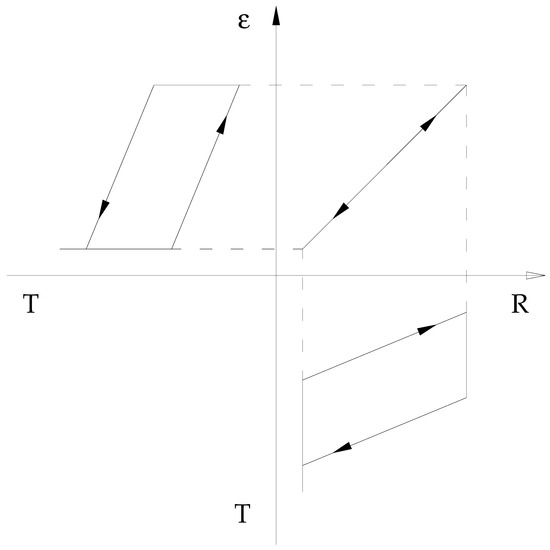
Figure 1

Journal Menu
► ▼ Journal Menu-
- Micromachines Home
- Aims & Scope
- Editorial Board
- Reviewer Board
- Topical Advisory Panel
- Instructions for Authors
- Special Issues
- Topics
- Sections & Collections
- Article Processing Charge
- Indexing & Archiving
- Editor’s Choice Articles
- Most Cited & Viewed
- Journal Statistics
- Journal History
- Journal Awards
- Conferences
- Editorial Office
Journal Browser
► ▼ Journal BrowserHighly Accessed Articles
Latest Books
E-Mail Alert
News
12 April 2024
Meet Us at the 16th International Conference on Hybrid and Organic Photovoltaics, 13–15 May 2024, Valencia, Spain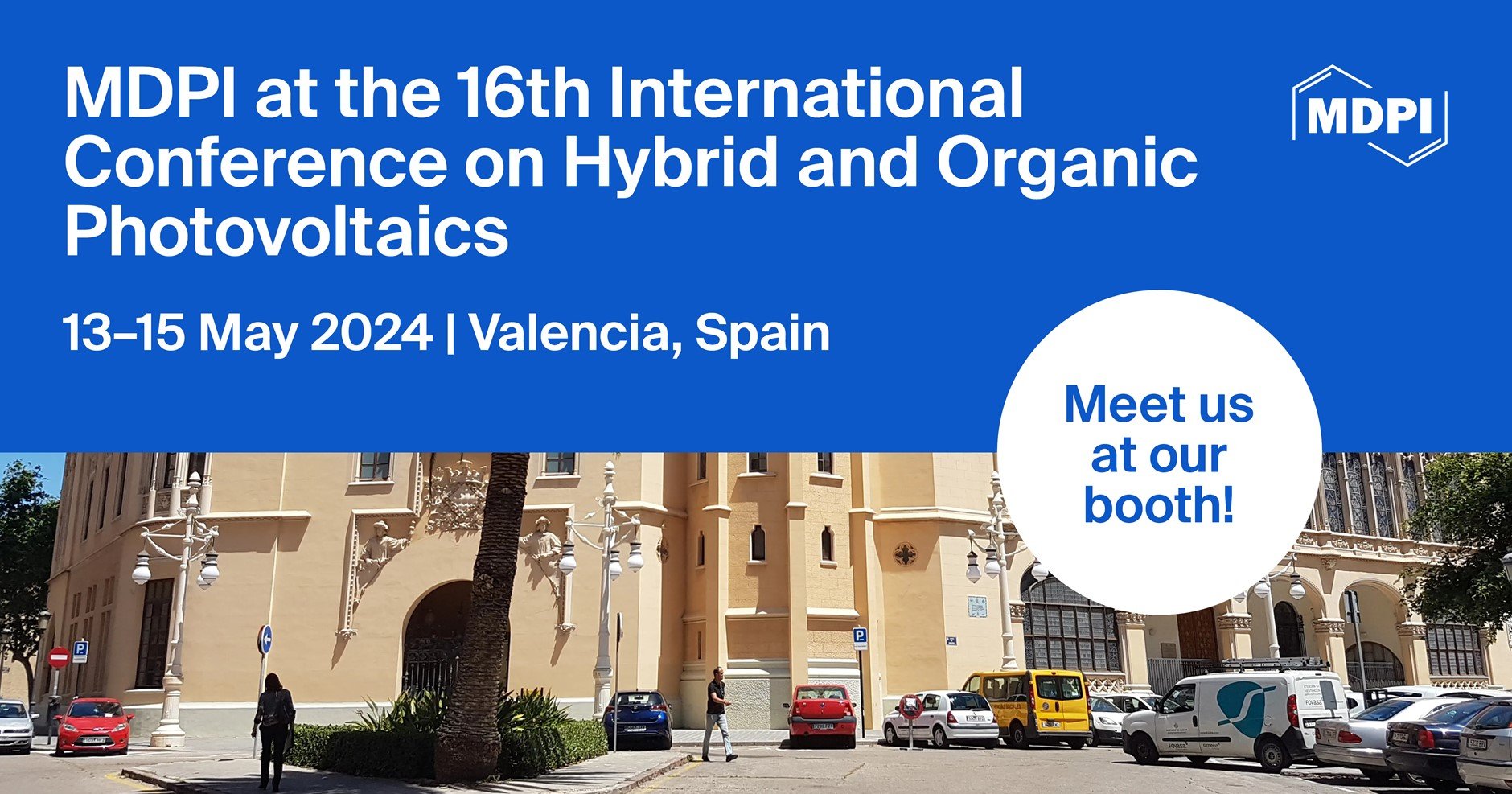
Meet Us at the 16th International Conference on Hybrid and Organic Photovoltaics, 13–15 May 2024, Valencia, Spain

Topics
Topic in
Bioengineering, JMMP, Materials, Micromachines, Polymers
Advances in Filament Engineering for Biomaterials
Topic Editors: Ming-Wei Chang, Zeeshan Ahmad, Hui-Min David WangDeadline: 30 June 2024
Topic in
Automation, Electronics, Eng, Hardware, Micromachines, Signals
New Development for Circuit Design: Synthesis, Modeling, Simulation, and Applications
Topic Editors: Nestor Evmorfopoulos, Alkiviadis Hatzopoulos, George I. StamoulisDeadline: 5 October 2024
Topic in
Applied Sciences, Electronics, Fluids, Micromachines, Processes, Inventions
Micro-Mechatronic Engineering
Topic Editors: Teng Zhou, Antonio F. MiguelDeadline: 31 October 2024
Topic in
Chemistry, Materials, Micromachines, Molecules, Photonics
Materials, Structure Designs and Device Fabrications for Highly Efficient/Long Lifetime Organic Light-Emitting Diodes
Topic Editors: Ping Chen, Jwo-Huei JouDeadline: 31 December 2024

Conferences
1–4 August 2024
The 1st International Conference on AI Sensors and The 10th International Symposium on Sensor Science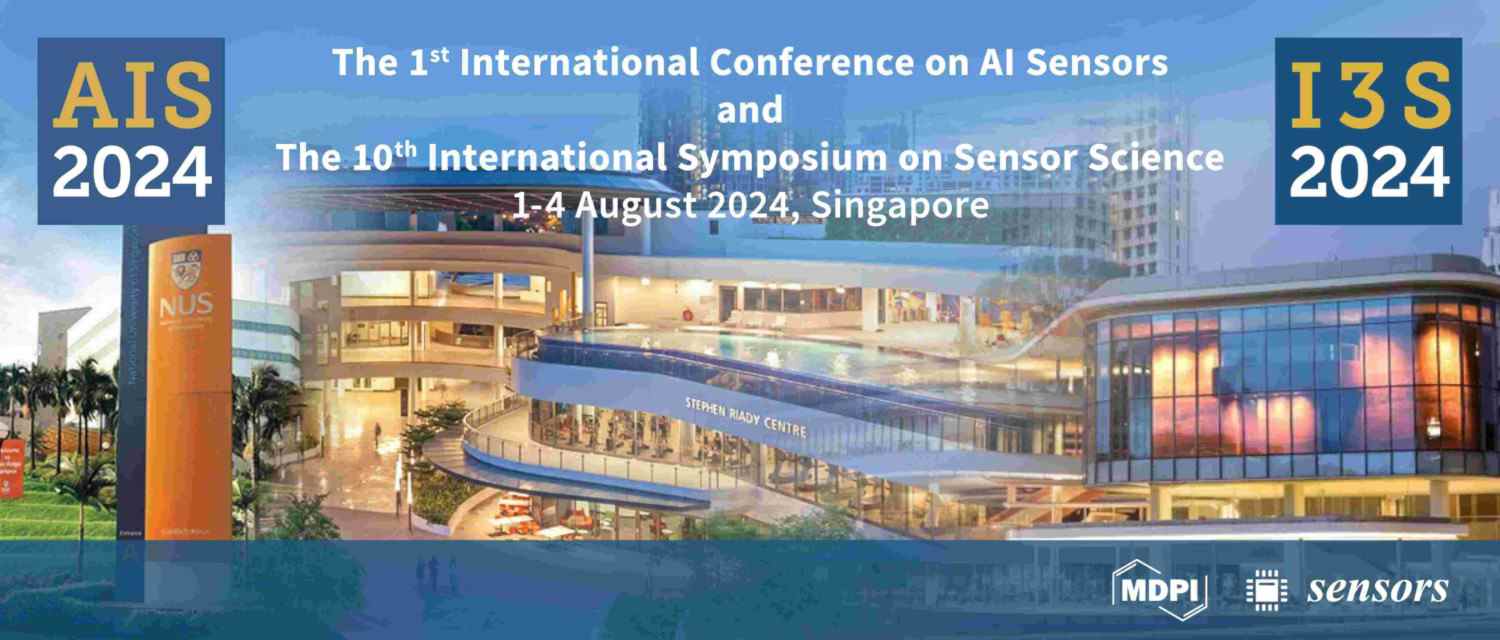

19–22 May 2024
7th International Conference Implementation of Microreactor Technology in Biotechnology

Special Issues
Special Issue in
Micromachines
Advances in Manufacturing, Characterization and Applications of Functional Micro/Nano Structured Surfaces
Guest Editors: Honggang Zhang, Nan Zhang, Wei Hang, Ruslan MelentievDeadline: 30 April 2024
Special Issue in
Micromachines
Methodology, Microfabrication and Applications of Advanced Sensing and Smart Systems
Guest Editors: Jianxiong Zhu, Zhisheng Zhang, Haiying WenDeadline: 15 May 2024
Special Issue in
Micromachines
Electron Microscopy and Single Molecule Studies of Biomolecular Structure and Dynamics
Guest Editor: Arkadiusz KulczykDeadline: 30 May 2024
Special Issue in
Micromachines
High-Quality Surface Integrity of Ultra-Precision Machining
Guest Editors: Huapan Xiao, Changlin Liu, Xiaoliang Liang, Yanbin Zhang, Kangsen LiDeadline: 15 June 2024
Topical Collections
Topical Collection in
Micromachines
Micromixers: Analysis, Design and Fabrication
Collection Editor: Kwang-Yong Kim
Topical Collection in
Micromachines
Piezoelectric Transducers: Materials, Devices and Applications
Collection Editor: Jose Luis Sanchez-Rojas
Topical Collection in
Micromachines
Micro/Nanoscale Electrokinetics
Collection Editor: Xiangchun Xuan





